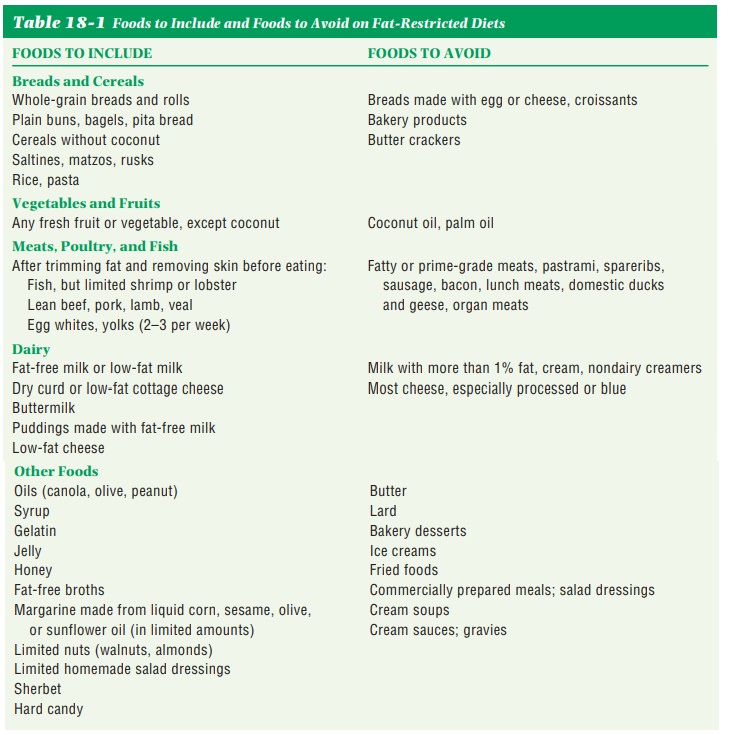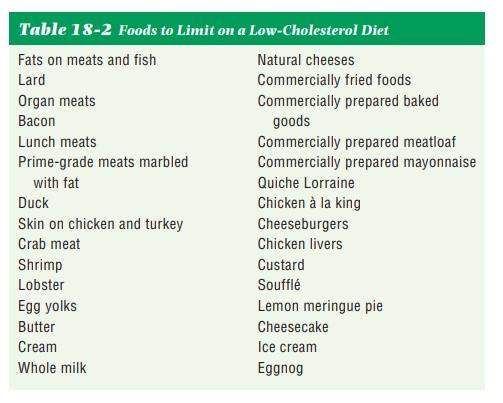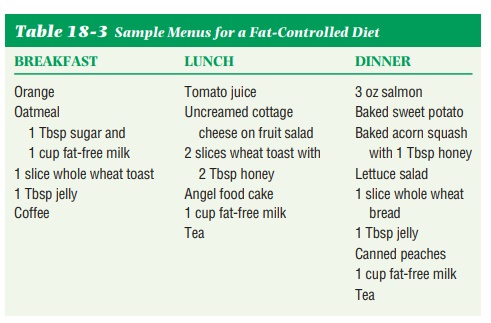Chapter: Nutrition and Diet Therapy: Diet and Cardiovascular Disease
Medical Nutrition Therapy for Hyperlipidemia
MEDICAL NUTRITION THERAPY
FOR HYPERLIPIDEMIA
Medical nutrition
therapy is the primary treatment for hyperlipidemia. It involves reducing the
quantity and types of fats and often calories in the diet. When the amount of
dietary fat is reduced, there is typically a corresponding reduction in the
amount of cholesterol and saturated fat ingested and a loss of weight. In
over-weight persons, weight loss alone will help reduce serum cholesterol
levels.
The American Heart
Association categorizes blood cholesterol levels of 200 mg/dl or less to be
desirable, 200 to 239 mg/dl to be borderline high, and 240 mg/dl and greater to
be high.
In an effort to
prevent heart disease, the American Heart Association has developed guidelines
in which it is recommended that adult diets contain less than 200 mg of
cholesterol per day and that fats provide no more than 20% to 35% of calories,
with a maximum of 7% from saturated fats and trans fat, a maximum of 8% from
polyunsaturated fats, and a maximum of 15% to 20% of monounsaturated fats.
Carbohydrates should make up 50% to 55% of the calories and proteins from 12%
to 20% of them. Currently, it is believed that nearly 40% of the calories in
the average U.S. diet come from fats.
A fat-restricted diet
can be difficult for the client to accept. A diet very low in fat will seem unusual and highly
unpalatable (unpleasant-tasting) to most clients. It takes approximately 2 or 3
months to adjust to a low-fat diet. If the physician will allow it, the change
in the nutrient makeup of the diet should be made gradually (Table 18-1).

Information about the
fat content of foods and methods of preparation that minimize the amount of fat
in the diet are essential to the client. The client must be taught to select
whole, fresh foods and to prepare them without the addition of any fat. Only
lean meat should be selected, and all visible fat must be removed. Fat-free
milk and fat-free milk cheeses should be used instead of whole milk and natural
cheeses. Desserts containing whole milk, eggs, and cream are to be avoided.
In a fat-controlled
diet, one must be particularly careful when using animal foods. Cholesterol is
found only in animal tissue. Organ meats, egg yolks, and some shellfish are
especially rich in cholesterol and should be used in limited quantities, if at
all. Saturated fats are found in all animal foods and in coconut, chocolate,
and palm oil. They tend to be solid at room temperature. Polyunsaturated fats
are derived from plants and some fish and are usually soft or liquid at room
temperature. Soft margarine containing mostly liquid vegetable oil is substituted
for butter, and liquid vegetable oils are used in cooking.
Studies indicate that
water-soluble fiber, such as that found in oat bran, legumes, and fruits, bind
with cholesterol-containing substances and prevent their reabsorption by the
blood. It is thought that 20 to 25 grams of soluble fiber a day will
effectively reduce serum cholesterol by as much as 15%. This is a large amount
of fiber and must be introduced gradually to the diet along with increased
fluids or the client will suffer from flatulence. Table 18-2 lists foods to
limit on a low-cholesterol diet.

Some clients will find
the diabetic exchange lists useful for controlling the fat content of their
diets. When fat-controlled diets are severely restricted, limiting calorie
intake to 1,200, they may be deficient in fat-soluble vitamins. Consequently, a
vitamin supplement may be needed.
If appropriate blood
lipid levels cannot be attained within 3 to 6 months by the use of a fat-restricted
diet alone (see Table 18-3 for menus), the physician can prescribe a
cholesterol-lowering drug such as atorvastatin (Lipitor) or simvas-tatin
(Zocor). Food and/or drug interactions can occur with cholesterol-lowering
drugs, as well as with other cardiac drugs. For example, Zocor and Lipitor
interact with grapefruit and its juice; therefore total avoidance is necessary.

Related Topics